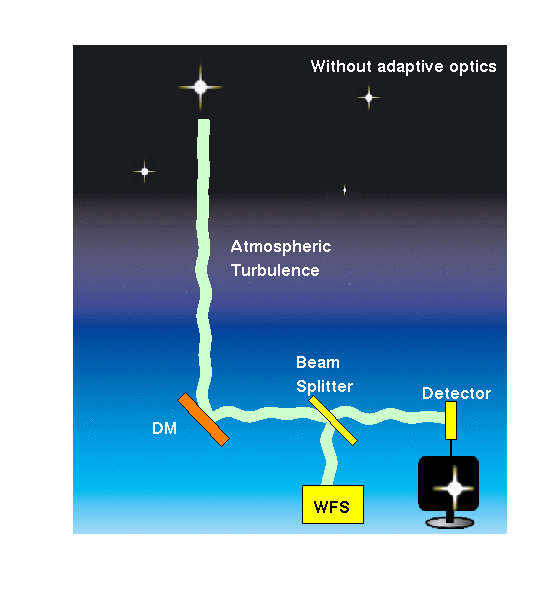-
Photos First Annual meeting of SOS programme
See the photos of the First Annual meeting (2010) in Scheveningen Adaptive Optics introduction article (in Dutch)
Rufus Fraanje en Michel Verhaegen, Slimme optische systemen compenseren voor dynamische verstoringen, Fotonica Magazine, Dec. 2011Comparison between classical and optimal predictive Adaptive Optics
Read more on this research at the research page...-
Principle of adaptive optics
The principle of AO is illustrated in the animation. Light from distant stars or (exo-)planets is distorted by variations in the refraction index of the air in the atmosphere. This variation is due to air flows (wind) that moves air bubbles with constant temperature. Because the air flow in the atmosphere has a turbulent character this distortion is called atmospheric turbulence.
Of course in reality air bubbles with constant temperature do not exist, the temperature is continuously distributed in space and time. But, depending on the strength of the turbulence, the temperature can be thought of as constant over a particular distance. This distance is also called the Fried parameter and equals the diameter of the fictitious bubbles. The Fried parameter is usually in the range of 10-20cm.
When the telescope aperture is smaller or equal in diameter to the Fried parameter, light from only one bubble with constant temperature and thus constant refraction index will be received, and thus we will observe an image of the star or planet which is only moved. The variation of the temperature in time will result in a constant moving of the image. This distortion is called a tip-tilt distortion and can be usually suppressed by means of a flat mirror which horizontal and vertical angle can be continuously adjusted by means of a controller such that the observed image is centered on the detection screen.
When the aperture of the telescope increases (above the Fried parameter, so typically more than 10-20cm in diameter), light from several bubbles with different diffraction index will be observed, such that several parts of the image will move in different directions and in different extend. In this way higher order optical distortions are introduced, such as focus, astigmatism, coma, etc. Even these distortions can be compensated, but this needs an other active optical component which can compensate for these higher order distortions.
Such a component is a deformable mirror (DM), which surface can be more or less independently altered by means of actuators attached to the mirror surface at a (large) number of different places. By controlling the actuators in a particular way, tip/tilt, focus, astigmatism and higher order optical distortions or arbitrary combinations can be actuated, depending on the number and positions of the actuators. So if at a particular time instance, the distortion of the light is known, the deformable mirror will be actuated by the controller such that its surface has the shape of the negative of the distortion such that the net effect of the distortion vanishes.
But, to be able to determine the distortion of the light, knowledge of its intensity (as measured by CCD or CMOS cameras), is not enough, but also phase information is needed. The phase of the light can be determined by means of a wavefront sensor (WFS). Several types of WFS's are available, among which the Shack Hartmann, the curvature, the shearing interferometer and the pyramid sensor.